
The Lakota are a Native American people. Also known as the Teton Sioux, they are one of the three prominent subcultures of the Sioux people, with the Eastern Dakota (Santee) and Western Dakota (Wičhíyena). Their current lands are in North and South Dakota. They speak Lakȟótiyapi—the Lakota language, the westernmost of three closely related languages that belong to the Siouan language family.

The Sioux or Oceti Sakowin are groups of Native American tribes and First Nations people from the Great Plains of North America. The Sioux have two major linguistic divisions: the Dakota and Lakota peoples. Collectively, they are the Očhéthi Šakówiŋ, or "Seven Council Fires". The term "Sioux", an exonym from a French transcription ("Nadouessioux") of the Ojibwe term "Nadowessi", can refer to any ethnic group within the Great Sioux Nation or to any of the nation's many language dialects.

Effigy Mounds National Monument preserves more than 200 prehistoric mounds built by pre-Columbian Mound Builder cultures, mostly in the first millennium CE, during the later part of the Woodland period of pre-Columbian North America. Numerous effigy mounds are shaped like animals, including bears and birds.
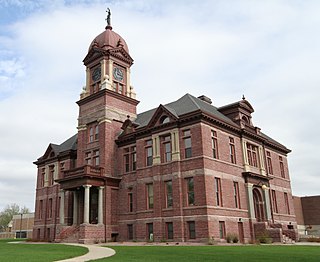
Pipestone County is a county in the U.S. state of Minnesota. As of the 2020 census, the population was 9,424. Its county seat is Pipestone.

Pipestone is a city and the county seat of Pipestone County, Minnesota. The population was 4,215 at the 2020 census. The city is also the site of the Pipestone National Monument.
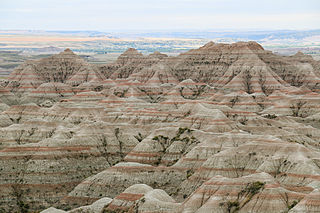
Badlands National Park is an American national park in southwestern South Dakota. The park protects 242,756 acres of sharply eroded buttes and pinnacles, along with the largest undisturbed mixed grass prairie in the United States. The National Park Service manages the park, with the South Unit being co-managed with the Oglala Lakota tribe.

The Coteau des Prairies is a plateau approximately 200 miles in length and 100 miles in width, rising from the prairie flatlands in eastern South Dakota, southwestern Minnesota, and northwestern Iowa in the United States. The southeast portion of the Coteau comprises one of the distinct regions of Minnesota, known as Buffalo Ridge. The tip of the feature starts in extreme south North Dakota.

Catlinite, also called pipestone, is a type of argillite, usually brownish-red in color, which occurs in a matrix of Sioux Quartzite. Because it is fine-grained and easily worked, it is prized by Native Americans, primarily those of the Plains nations, for use in making ceremonial pipes, known as chanunpas or čhaŋnúŋpas in the Lakota language. Pipestone quarries are located and preserved in Pipestone National Monument outside Pipestone, Minnesota, in Pipestone County, Minnesota, and at the Pipestone River in Ontario, Canada.
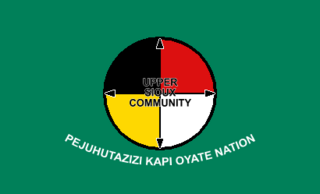
The Upper Sioux Indian Reservation, or Pezihutazizi in Dakota, is the reservation of the Upper Sioux Community, a federally recognized tribe of the Dakota people, that includes the Mdewakanton.
The Minnesota Indian Affairs Council (MIAC) is an intergovernmental body established by the U.S. state of Minnesota to serve as a liaison between state government and the Native American tribes residing within the state's boundaries. Created by the Minnesota Legislature, MIAC aims to improve relationships, facilitate dialogue, and address issues of mutual concern between the State of Minnesota and the tribal governments. The council plays a critical role in advising on policy, advocating for indigenous rights, and promoting cultural understanding.

A bowl, when referred to in pipe smoking, is the part of a smoking pipe or bong that is used to hold tobacco, cannabis, or other substances.

Buffalo Ridge is a large expanse of rolling hills in the southeastern part of the larger Coteau des Prairies. It stands 1,995 feet (608 m) above sea level. The Buffalo Ridge is sixty miles (97 km) long and runs through Lincoln, Pipestone, Murray, Nobles, and Rock counties in the southwest corner of Minnesota, and Minnehaha, Moody, and Lincoln counties in southeast South Dakota.

Coldwater Spring is a spring in the Fort Snelling unorganized territory of the U.S. state of Minnesota, that is considered a sacred site by the Dakota people, and was also the site of the U.S. Army's Camp Coldwater for troops that constructed Fort Snelling. Coldwater Spring is located on the west bluffs of the Mississippi River directly south of Minnehaha Park and adjacent to Fort Snelling State Park. Waters from the naturally occurring spring flow continuously year round and remain unfrozen in winter months. The spring and surrounding area is managed as a protected historic site and natural park by the National Park Service as part of the Mississippi National River and Recreation Area.
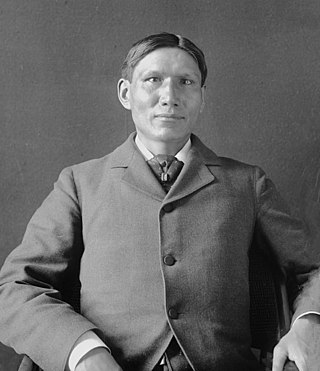
The Dakota are a Native American tribe and First Nations band government in North America. They compose two of the three main subcultures of the Sioux people, and are typically divided into the Eastern Dakota and the Western Dakota.

The Yankton Sioux Tribe of South Dakota is a federally recognized tribe of Yankton Western Dakota people, located in South Dakota. Their Dakota name is Ihaƞktoƞwaƞ Dakota Oyate, meaning "People of the End Village" which comes from the period when the tribe lived at the end of Spirit Lake just north of Mille Lacs Lake.

The Sioux Quartzite is a Proterozoic quartzite that is found in the region around the intersection of Minnesota, South Dakota, and Iowa, and correlates with other rock units throughout the upper midwestern and southwestern United States. It was formed by braided river deposits, and its correlative units are thought to possibly define a large sedimentary wedge that once covered the passive margin on the then-southern side of the North American craton. In human history, it provided the catlinite, or pipestone, that was used by the Plains Indians to carve ceremonial pipes. With the arrival of Europeans, it was heavily quarried for building stone, and was used in many prominent structures in Sioux Falls, South Dakota and shipped to construction sites around the Midwest. Sioux Quartzite has been and continues to be quarried in Jasper, Minnesota at the Jasper Stone Company and Quarry, which itself was posted to the National Register of Historic Places on January 5, 1978. Jasper, Minnesota contains many turn-of-the-century quartzite buildings, including the school, churches and several other public and private structures, mostly abandoned.
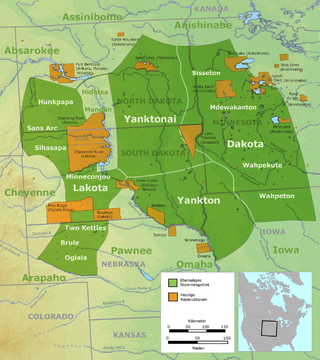
The Yankton Treaty was a treaty signed in 1858 between the United States Government and the Yankton Sioux Tribe, that ceded most of eastern South Dakota to the U.S. Government. The treaty was signed in April 1858, and ratified by the United States Congress on February 16, 1859.
Cresson is an unincorporated community located in Pipestone County, Minnesota, United States. The elevation is 1,673 feet. Cresson appears on the Elkton SW U.S. Geological Survey Map.
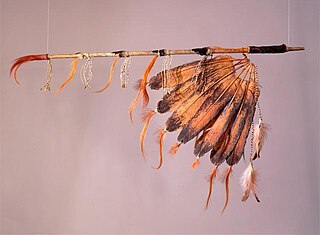
A ceremonial pipe is a particular type of smoking pipe, used by a number of cultures of the indigenous peoples of the Americas in their sacred ceremonies. Traditionally they are used to offer prayers in a religious ceremony, to make a ceremonial commitment, or to seal a covenant or treaty. The pipe ceremony may be a component of a larger ceremony, or held as a sacred ceremony in and of itself. Indigenous peoples of the Americas who use ceremonial pipes have names for them in each culture's Indigenous language. Not all cultures have pipe traditions, and there is no single word for all ceremonial pipes across the hundreds of diverse Native American languages.
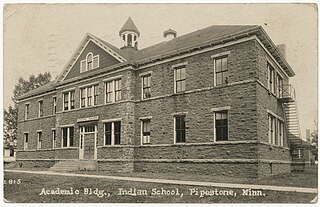
The Pipestone Indian Training School was a Native American boarding school in Pipestone, Minnesota that was established in 1894, and closed in 1953. The school was operated by the Bureau of Indian Affairs, as one of its 18 non-reservation boarding schools and last of such to be closed. The site of the school is adjacent to Pipestone National Monument, and is now used by the national monument and Minnesota West Community and Technical College. The superintendent's house of the old boarding school is on the U.S. National Register of Historic Places.






























